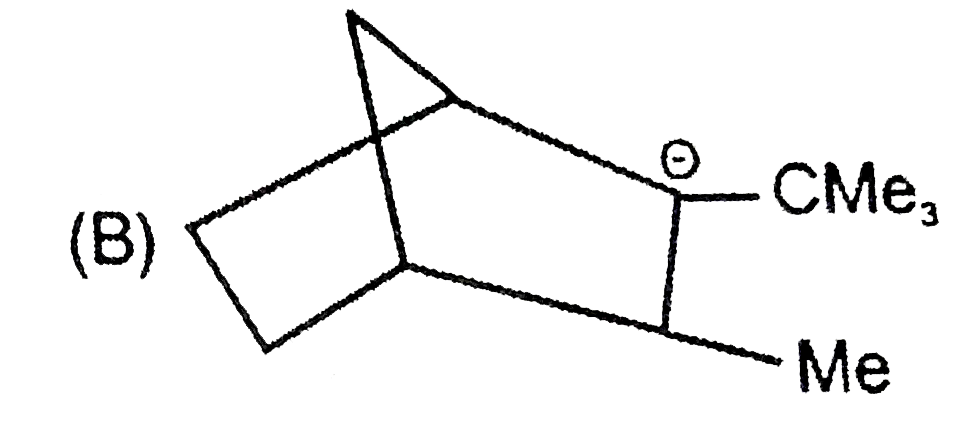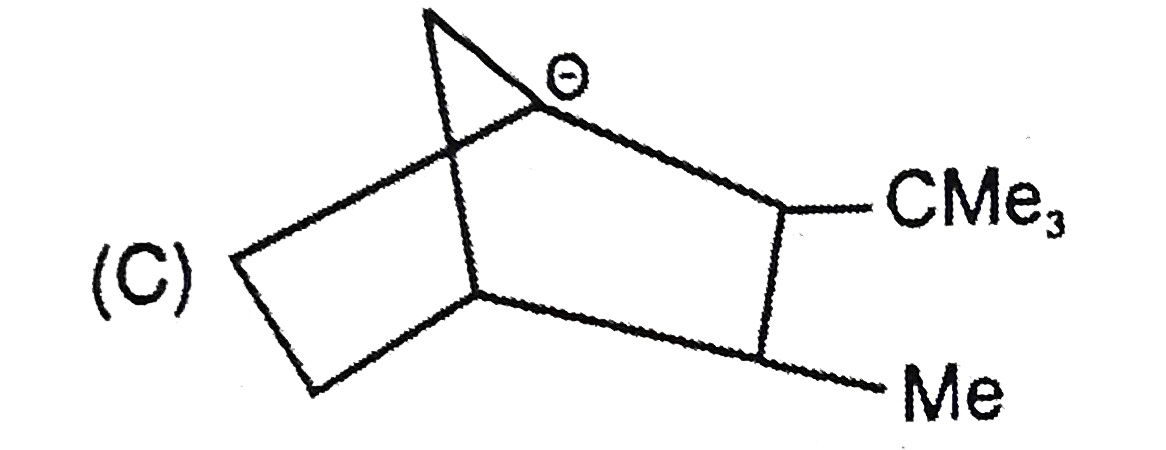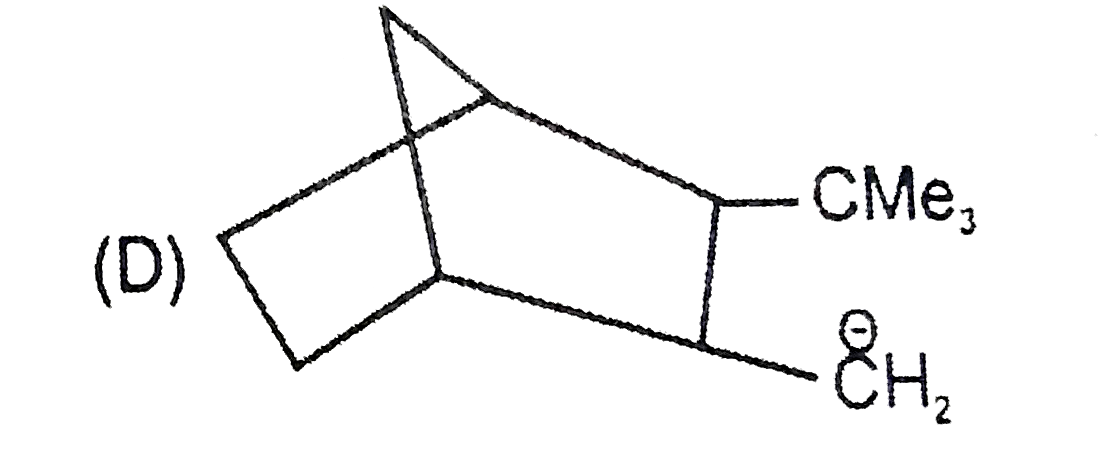"Stability of carbocations depends upon the electron releasing inductive effect of groups adjacent to positively charged carbon atom involvement of neighbouring groups in hyperconjugation and resonance."
Which of the following ions is more stable ? Use reasonance to explain your answer.

Out of these two structures, structure A is more stable than B. This is because, there is resonance in structure A but no resonance is possible in structure B.
Topper's Solved these Questions
- ORGANIC CHEMISTRY: BASIC PRINCIPLES AND TECHNIQUESBook:MODERN PUBLICATIONChapter:ORGANIC CHEMISTRY: BASIC PRINCIPLES AND TECHNIQUESExercise:NCERT EXEMPLAR PROBLEMS ( Matching Type Questions )
Explore 6 Videos
- ORGANIC CHEMISTRY: BASIC PRINCIPLES AND TECHNIQUESBook:MODERN PUBLICATIONChapter:ORGANIC CHEMISTRY: BASIC PRINCIPLES AND TECHNIQUESExercise:NCERT EXEMPLAR PROBLEMS ( Assertion and Reason Type Questions )
Explore 4 Videos
- ORGANIC CHEMISTRY: BASIC PRINCIPLES AND TECHNIQUESBook:MODERN PUBLICATIONChapter:ORGANIC CHEMISTRY: BASIC PRINCIPLES AND TECHNIQUESExercise:NCERT EXEMPLAR PROBLEMS (Multiple Choice Questions (Type - II) )
Explore 7 Videos
- MOCK TEST-2Book:MODERN PUBLICATIONChapter:MOCK TEST-2Exercise:SECTION D
Explore 1 Video
- REDOX REACTIONS Book:MODERN PUBLICATIONChapter:REDOX REACTIONS Exercise:COMPETITION FILE (Objective Questions) (C. MULTIPLE CHOICE QUESTIONS)
Explore 9 Videos
Similar Questions
"Stability of carbocations depends upon the electron releasing inductive effect of groups adjacent to positively charged carbon atom involvement of neighbouring groups in hyperconjugation and resonance."
The structure of triphenylmethyl cation is given below. This is very stable and some of its salts can be stored for months. Explain the cause of high stability of this cation.

View Solution'Stability of carbocations depends upon the electron releasing inductive effect of groups adjacent to positively charged atom involvement of neighbouring groups in hyperconjugation and resonace''.
Write structure of various carbocations that can be obtained from 2-methylbutane. Arrange these carbocations in order of increasing stability
View Solution
Knowledge Check
Which of the following reagent is used to detect the presence of −OH groups on adjacent carbon atoms?
Aconc. H2SO4BOzoneCHIO4DConc. HNO3Reaction intermdiates are short lived species and are highly reactive. They are formed by heterolytic and homolytic bond fission. There are various types of reaction intermediates in which the most important are carbocation , carbanion and free radical.
Carbocation is an organic species in which carbon have positive charge and six electrons in its outermost shell. The stability of carbocation can be increased by positive inductive effect, hyperconjugation and delocalisation. If α-atom with respect to carbocation has one or more lone pair of electron then lone pair of electron strongly stabilises the carbocation due to octet completion.
Species in which carbon have negative charge is called carbanion. Carbanion carries three bond pairs and one lone pair. The stability of carbanion can be increased by negative inductive effect, negative mesomeric effect and delocalisation.
Free radical is a species which have seven electrons in its outermost shell. The stability of free radical can be increased by hyperconjugation and delocalisation.
Which of the following is the most stable carbanion intermediate ?A B
B C
C D
D
A large number of molecular rearrangements involve anionotropic migration of a group to an adjacent atom with incomplete octet. The migration group may either detach from the migration origin and then form bond with the migration terminus or may remain partly bonded to both migration origin and terminus to form a bridged ion intermediate. similar to the electron deficent carbon such as carbocation and carbene intermediates, electron-deficient nitrogen species are known in which the nitrogen bears a positive charge or the nitrogen has an open sextet of electrons, i.e., a nitrene.
Q. Which of the following is stable product for given reaction?
HO−CH2−CH2−CH2−CH2−OHH+−−→ ?AHO−CH2−CH2−CH2−CH=CH2B C
C D
D
'Stability of carbocations depends upon the electron releasing inductive effect of groups adjacent to positively charged atom involvement of neighbouring groups in hyperconjugation and resonace''.
Draw the possible resonance structures for CH3−..O..−+CH2 and predict which of the structures is more stable. Give reason for your answer.
View Solution'Stability of carbocations depends upon the electron releasing inductive effect of groups adjacent to positively charged atom involvement of neighbouring groups in hyperconjugation and resonace''.
Write structure of various carbocations that can be obtained from 2-methylbutane. Arrange these carbocations in order of increasing stability
View Solution'Stability of carbocations depends upon the electron releasing inductive effect of groups adjacent to positively charged atom involvement of neighbouring groups in hyperconjugation and resonace''.
Draw the possible resonance structures for CH3−..O..−+CH2 and predict which of the structures is more stable. Give reason for your answer.
View SolutionII. Read the following passage and answer questions 6-10 that follow :
During organic reactions, a covalent bond between two carbon atoms or carbon atom and some other atom is broken and a new bond is formed. The fission of bonds can be homolytic or heterolytic forming free radicals, carbocations carbanions, carbenes, etc. This also depends upon the displacement, of electron in a bond and is governed by inductive effect, electromeric effect, reasonance and hyperconjugation.
Which of the following is most stable and why?
CH−3,−CH2CI,−CHCI2,−CI3
View SolutionReaction intermdiates are short lived species and are highly reactive. They are formed by heterolytic and homolytic bond fission. There are various types of reaction intermediates in which the most important are carbocation , carbanion and free radical.
Carbocation is an organic species in which carbon have positive charge and six electrons in its outermost shell. The stability of carbocation can be increased by positive inductive effect, hyperconjugation and delocalisation. If α-atom with respect to carbocation has one or more lone pair of electron then lone pair of electron strongly stabilises the carbocation due to octet completion.
Species in which carbon have negative charge is called carbanion. Carbanion carries three bond pairs and one lone pair. The stability of carbanion can be increased by negative inductive effect, negative mesomeric effect and delocalisation.
Free radical is a species which have seven electrons in its outermost shell. The stability of free radical can be increased by hyperconjugation and delocalisation.
The stability order of following carbocations is

View Solution